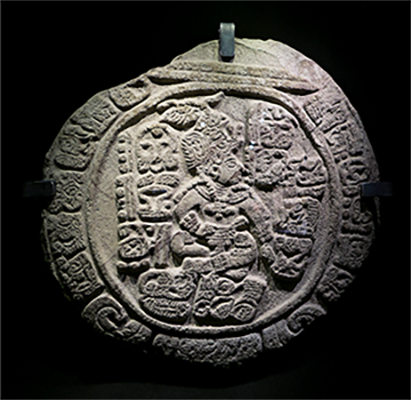Quirigua Altar L
Location: Quirigua, Exact Location Unsure
Dates:
- 9.11.0.0.0 12 Ajaw / 653 CE
- Dedicated 9.11.0.11.11 9 Chuwen 14 Zec / June 2, 653 CE
Ruler: 12
Measurements: 3.28 feet diameter, .82 feet thick

José C. Altar L de Quirigua, December 2017, photograph. Wikimedia Commons.
During K’ahk Uti’ Witz’ K’awiil’s reign, Quirigua erected this fascinating altar to celebrate the k’atun ending (Martin and Grube 2008, 217). While the altar would be found in the Acropolis, its original location has yet to be conclusively determined. This rhyolite circular altar features the then current king of Quirigua K’awiil Yopaat facing right and sitting cross-legged on two glyphs (Looper 2003, 51). Interestingly, this altar is the only record we have of this king. His succession number is not even known, and he is the only king recorded between the third ruler in 480 and K’ahk’ Tiliw Chan Yopaat in 724 (Martin and Grube 2008, 216-218). The altar is carved in the Great Ajaw style, in which a large depiction of the ruler indicates the Ajaw day name (Looper 2003, 50-51).
The king is adorned with a large collar, belt, wristlets, and anklets. He wears a winged serpent headdress with a Venus glyph to commemorate Venus’s rise coinciding with the k’atun (Looper 2003, 52). The figure is surrounded by a day sign cartouche (Looper 2003, 51). A double bar is present on top of this cartouche, and the text is both carved along the rim and surrounding the king within the cartouche (Looper 2003, 51).
The glyphs themselves are carved in a crude, unique style with high relief on the glyphs (Looper 2003, 52). Given that Copan was carving elaborate high relief monuments at the time, this altar must have been carved locally (Martin and Grube 2008, 217). Furthermore, the Great Ajaw altar style was never used at Copan, but was particularly popular in Caracol, where Quirigua was known to have political ties (Looper 2003, 53) The T168 Ajaw glyph carved into the altar had been popular in Copan during Butz’ Chan’s reign, but had fallen out of fashion by the time of the twelfth ruler (Looper 2003, 52). The glyph’s presence here either indicates Quirigua’s failure to follow trends closely or a deliberate decision to institute their own style.
The text describes a “house censing event”, and the king sits on glyphs describing dancing (“Ak’taj ti nep nah”) at a yet to be determined location (Looper 2003, 51). The text also mentions K’ahk Uti’ Witz’ K’awiil, the “divine Copan ajaw”, present for a tz’ak huli event (Looper 2003, 51; Martin and Grube 2008, 201). This event, roughly translated as “Conjured arrival here” is uncertain in its exact connotations.
The exact connotations present in this altar are likewise debatable. The fact that K’ahk Uti’ Witz’ K’awiil is directly mentioned during a k’atun ending inscription would suggest that Copan still held political dominion in Quirigua. Yet, Quirigua’s exact attitude toward the Copan king at this point is still unsure. The only other inscription mentioning tzak huli described two cities who had recently been at war, so tensions may have already been high (Martin and Grube 2008, 201). The k’in cartouche motif also typically referred to warfare, although the exact reference is unsure (Stone and Zender 2011, 153). At the same time, the twelfth ruler’s reign was the height of Copan expansion in the valley, and the altar may have been commissioned by the twelfth ruler to display his power (Looper 2003, 52). The use of an altar motif not commonly found in Copan might be Quirigua establishing their own sculptural identity, cultural diffusion from Caracol, or an act of defiance by creating a monument outside of Copan fashion.
Like the king who erected this monument, Altar L offers a fascinating if not inconclusive look into a period in which Quirigua was largely silent. The mention of Copan’s twelfth ruler certainly reveals the reach of his power regardless of political motive. With the reign of Waxaklajuun Ubaah K’awiil, the power dynamic between the two cities was about to drastically change, as would be evident on the next known Quirigua king K’ahk’ Tiliw Chan Yopaat’s Stela J.
Motifs:
- k'in cartouche
- Venus
See Also:
- Caracol Stela 16
- Quirigua Stela J
- Stela 2
- Stela 3
- Stela 10
- Stela 12
- Stela 13
- Stela 19
Sources:
- Looper, Matthew George. 2003. Lightning Warrior: Maya Art and Kingship at Quirigua. Austin: University of Texas Press.
- Martin, Simon and Nikolai Grube. 2008. Chronicle of the Maya Kings and Queens: Dynasties of the Ancient Maya. London: Thames and Hudson
- Stone, Andrea and Marc Zender. 2011. Reading Maya Art: A Hieroglyphic Guide to Ancient Maya Painting and Sculpture. London: Thames and Hudson.
Photograph
- Altar L de Quirigua, by José Luis Filpo Cabana is licensed under CC-BY-SA-4.0.